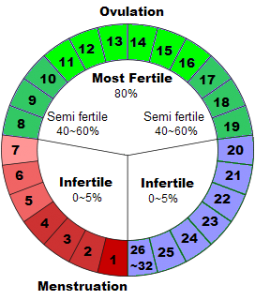Science > Biology > Human Population and Population Control > Natural Methods of Contraception
Birth control also known as contraception is the use of various devices, drugs, agents, sexual practices, or surgical procedures to prevent conception or pregnancy. It enables people to choose when they want to have a baby. Contraception may be a temporary or permanent measure to prevent pregnancy. Natural methods of contraception for birth control has been used since ancient times, but effective and safe methods of birth control only became available in the 20th century.
Family Planning:
Family planning is the practice of controlling the number of children one has and the intervals between their births, particularly by means of contraception or voluntary sterilization.
Logic Behind Use of Contraceptives:
A woman can get pregnant if a man’s sperm reaches one of her eggs (ova) and fertilizes it. Contraception tries to stop the reaching of sperms to the ova by:
- keeping the egg and sperm apart
- stopping egg production
- stopping the combined sperm and egg (fertilized egg) attaching to the lining of the womb
Chracteristics of Ideal Contraceptive:
- It should be easily available.
- It should be comfortable, easy to use and long lasting.
- It requires little or no medical supervision
- it should be effective and reversible with no or little side effects.
- It should not interfere with sexual desire, drive or the act of user.
- It should be economical.
Natural Methods of Contraception:
Natural methods of contraception are considered “natural” because they are not mechanical and not a result of hormone manipulation. These methods prevent pregnancy by not allowing the sperms to fertilize the ovum. These methods rely on observations about the woman’s body and menstrual cycle. They include fertility awareness methods.
The cheapest natural methods of contraception are fertility awareness methods (FAMs), which are based upon knowing when a woman ovulates each month. In order to use a FAM, it is necessary to watch for the signs and symptoms that indicate ovulation has occurred or is about to occur.

Safe Period or Rhythm Method:
The rhythm method also called the calendar method or a calendar rhythm method is a form of natural family planning. Women are only fertile (When the egg is present) for a few days each month. Women using the rhythm method monitor their body and analyze their past menstrual cycle to try to determine when their fertile days are. They can then either choose to not have sex during those days or can use a “barrier” form of birth control, such as condoms or spermicide.
Ovulation takes place on about the 14th day of the menstruation in a 28-day menstruation cycle. The lifespan of an ovum is of 1-2 days only while the sperms can survive for about 3 days in the female genital tract. Thus sexual intercourse without barriers should be avoided from day 10th to 17th of the menstruation i.e. few days before and after ovulation.
The rhythm method works best for women whose cycles are consistent because it is easier to predict when she ovulates (releases an egg from her ovaries). But in most of the cases, the periods are uneven, hence the exact date of ovulation cannot be predicted. Hence the effectiveness of this method is limited. This method doesn’t protect the woman from sexually transmitted infections.
The basal body temperature method:
This method is also called a fertility awareness-based method. A Basal body temperature (BBT or BTP) is the lowest body temperature attained during rest (usually during sleep). It is usually estimated by a temperature measurement immediately after awakening and before any physical activity has been undertaken. Ovulation may cause a slight increase in basal body temperature. This is caused by the increase in the hormone progesterone. The female is most fertile during the two to three days before the basal temperature rises. By tracking the basal body temperature each day, a female may be able to predict when she will ovulate. Sexual intercourse without barrier should be avoided a few days before and after ovulation (Increase in the basal temperature).
Cervical Mucus Examination Method:
The cervical mucus method also called the Billings Ovulation Method. The cervical mucus method is based on careful observation of mucus patterns during the course of a female’s menstrual cycle. Just before ovulation occurs, the hormone estrogen leads to increased cervical mucus and changes it into a stretchy, viscous-like substance. This helps sperm survive and swim through the cervix, uterus and fallopian tubes to the egg. By recognizing the changing characteristics of the cervical mucus, the prediction of ovulation can be done. If the cervical mucus is dry or sticky it represents nonovulation period. If it is wet and watery it represents ovulation is nearing. If it is creamy it represents ovulation is coming. When it is wet, stretchy and resembles raw egg white it represents ovulation. Sexual intercourse without a barrier should be avoided a few days before and after ovulation. This method doesn’t protect the woman from sexually transmitted infections.
Withdrawal Method or Coitus Interruption:
This method is used during sexual intercourse. The withdrawal method is the practice of withdrawing the penis from the vagina and away from a woman’s external genitals before ejaculation to prevent pregnancy. The goal of the withdrawal method is to prevent sperm from entering the vagina. This is one of the oldest methods of family planning. This method is also not effective because there is a possibility that some sperms may pass into the vagina. This method doesn’t protect the woman from sexually transmitted infections.
Lactational Amenorrhoea:
Lactational amenorrhea is the temporary postnatal infertility that occurs when a woman is amenorrheic (not menstruating) and fully breastfeeding. This is a natural barrier but effective only for 6 months after the parturition.
Previous Topic: Social and Economic Measures for Population Control
Next Topic: Barrier Methods of Contraception